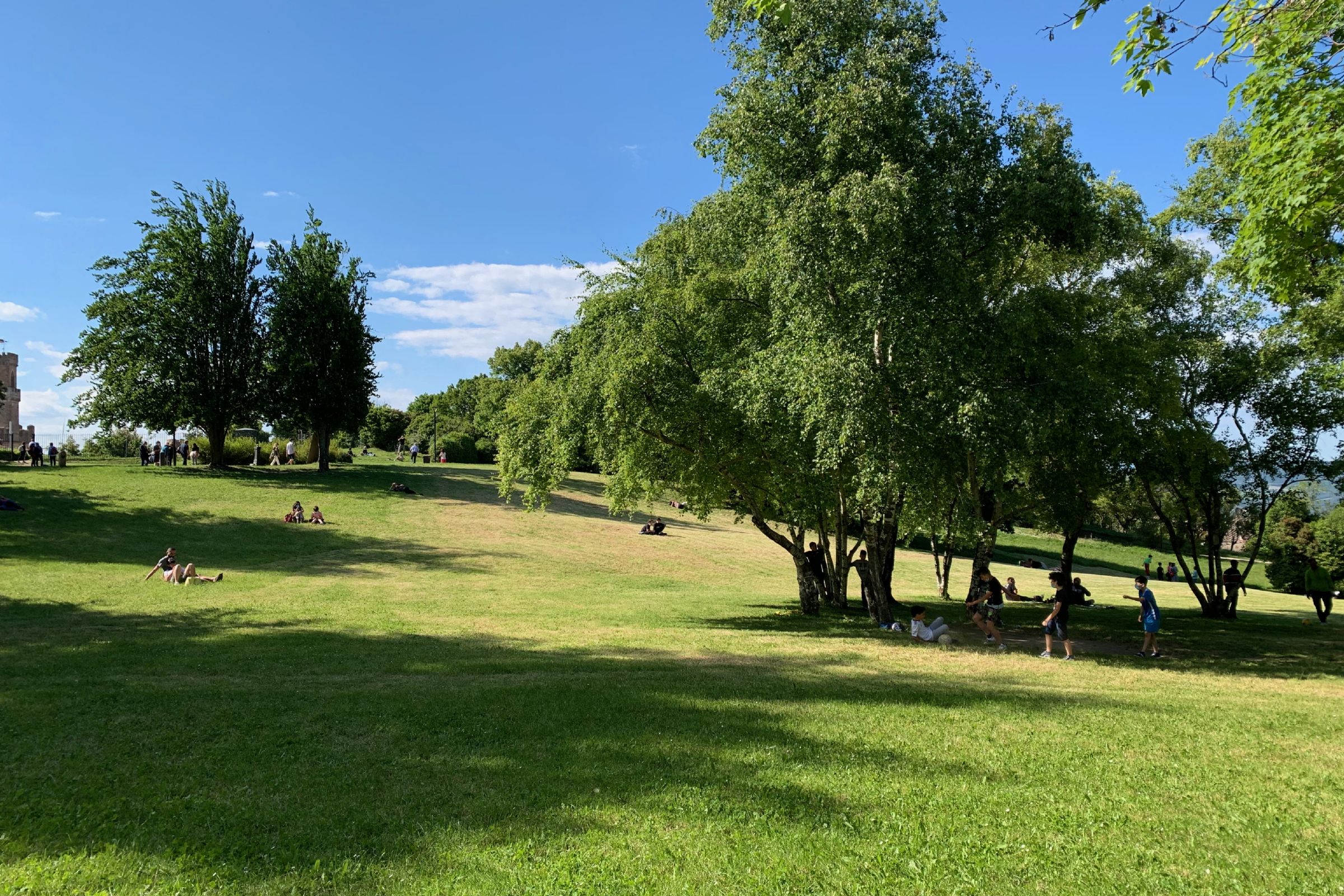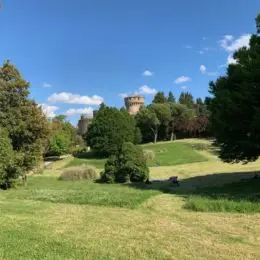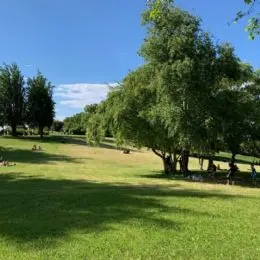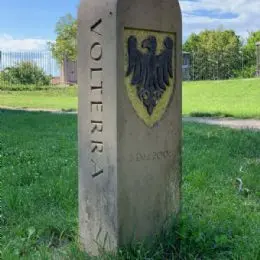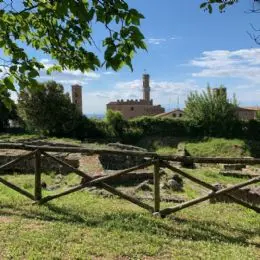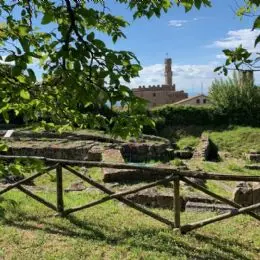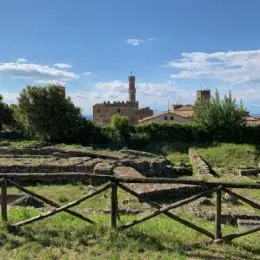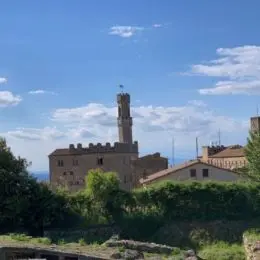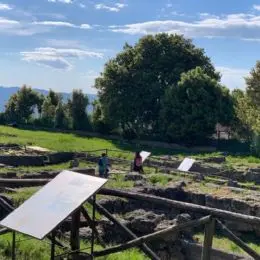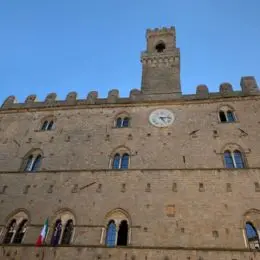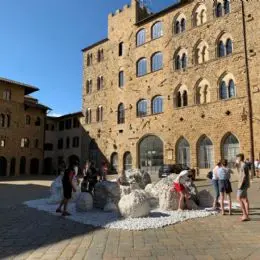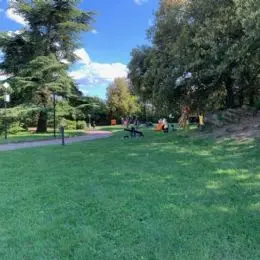Volterra artistic itineraries
- A route from Piazza dei Priori at the Archaeological Museum Guarnacci
- Route B Outside the Walls A route from Piazza dei Priori to the Etruscan Museum Guarnacci
Piazza dei Priori
This is the place that has retained more traces of the medieval past of Volterra. The square is surrounded by tall buildings with stone facades fit pierced by single and mullioned windows, on which the rising towers. Among the buildings will emerge, for architectural quality, two, both of the thirteenth century, the palace Pretorio ancient residence of the Capitano del Popolo, with large arches on the ground and the tower called Piggy and the Palazzo dei Priori, the oldest municipal building still Italian, and the Town Hall, whose fa?ade, tall and austere, closed with a pentagonal tower Two shelves embattled. From the belfry, you can enjoy a magnificent panorama of the city.
The only hint of color is formed by bands white and black ornant the transept of the cathedral which leans to the building. So we go to visit him.Piazza San Giovanni
If the Piazza dei Priori is the period since the focus of communal politics town, the Piazza San Giovanni is the center of religious life. Here, in fact, facing the cathedral, the baptistery and the palace of the Bishops.Duomo
Built in style Romanesque in the twelfth century, it was built in the thirteenth century. The fa?ade, rather bare, is twofold. Inside, the fruit of actions century, contains some valuable works such as a marble ciborium by Mino da Fiesole and a pulpit built in the seventeenth century by mounting a suppellettile parts of the liturgy of the twelfth century, attributed to the school of William Pisano. But over all stands a magnificent example of thirteenth-century wooden sculpture depicting The Deposition, incredibly well preserved, deserves attention and admiring the vibrant colors.Diocesan museum
Housed in the Bishop's palace, works from the cathedral and other churches in the diocese of Volterra. Among these is appropriate to point out the bust of San Lino, glazed terracotta by Andrea della Robbia, the bust of Saint Ottaviano embossed in silver and engraved by Antonio del Pollaiolo and Madonna enthroned between saints of Rosso Fiorentino.Battistero
Placed before the cathedral, one can admire a beautiful font by Andrea Sansovino and water obtained from an Etruscan stone.Battistero take along a small road at the end of which we leave for a moment the town walls and admire the door all'Arco, perhaps the 'single Left example of civil architecture etrusca. The door was then inserted in the Roman walls and medieval. The jambs, tuffaceous limestone containing fossil shells, are Etruscan, while the archway with the three heads probably placed to protect the city, are from Roman times.
We return to this point in Piazza San Giovanni and Rome turn away; at the point where the road crosses via Ricciarelli is one of the most characteristic of Volterra, known as the crossroads of Buonparenti since there ahead towers, bridge and tower houses. We all Buomparenti away at the bottom there is the palace-Solaini Minucci, current seat of the civic art gallery.
Picture Gallery
The gallery of paintings is organized in rooms of one of the most beautiful palaces Volterra, built in the fifteenth century to a design attributed to Antonio da Sangallo the Old. Large is the group of works that deserve to make a visit to this gallery. All undoubtedly dominates the Deposition by Rosso Fiorentino, a real masterpiece of Mannerist. We must pay attention also to the beautiful Annunciation by Luca Signorelli.After the exit turn away Minucci then taking the path along the wall of the Almonds Sarti. Questra road borders in the area which were found important remains of a Roman theater of the Augustan period, which for centuries has been used as landfill waste and then covered with layers of waste material, which allowed him to come down to us in good condition. Fiorentina reached the door, walk away Guarnacci until you reach Piazza San Michele and then turn into Via dei Sarti which overlooks Viti palace, one of the most beautiful private residences open to the public. Let us grab the opportunity to fly to visit his rooms.
Palazzo Viti
The house of Joseph Perrier from Volterra, dell'alabastro wealthy businessman, opened a few years its doors to tourists by allowing you to admire its twelve rooms sumptuously equipped with furniture, paintings, china, collection of alabaster and other furniture of great value, belonging to art Italian, European and East from the fifteenth to the twentieth century. Among the most important pieces of the two emerging monumental alabaster chandelier made for the Hapsburg Emperor Maximilian of Mexico, remained unsold because of his shooting occurred at Queretaro in 1867. A witness to the origin rather heterogeneous collection of works, due to the numerous trips made by the screws all over the world, you can remember the temple of Bali in balsa wood and ivory Chinese junk, the birds of paradise of New Guinea, the Japanese travel writing in lacquer and mother of pearl and porcelain lampshade incisa, the wonderful and rare work of real factories of Berlin.Let's go back to Piazza San Michele and take Via Matteotti, where you Allegretti curved tower rises in the Marquis until we find the main entrance of the palace Inghirami where Luchino Visconti shot most scenes Vaghe stars dell'orsa , In which film won the Golden Lion in Venice. Entering the rooms you can go wandering through the corridors that have seen the great head Claudia Cardinale.
Then going through the castle we reach the next stage of this visit: the archaeological park, walking in this vast green area, situated on top of the hill, one can observe the witnesses who were stratified during the Etruscan, Roman and medieval.
In the background there appears in all its grandeur, the bulk of that fortress, built by the Florentines for military purposes, was soon employed as a prison, depending on who plays today.
At this point we reach Minzoni way along the last leg of this tour: the museum Guarnacci.
Archaeological Museum Guarnacci
The museum collection contains more full of Etruscan Italy. It is precisely that section to be the backbone of the collections there. Among the many works on which I shall not interest, leaving you the pleasure to see this personally, there is one that you must at least mention it is the 'Shadow of the night, naked male figure, so named for its slender form and lean.Route B Outside the Walls
This route is preferred to go by car, moving away from San Lino leads through St. Francis, you can quickly reach the grassy above which stands the church of Saints Giusto and Clemente, framed by two rows of cypresses. Its construction was begun in 1627 in place of the fallen inexorably to the rise of flounces, particular forms of soil erosion and extras. Looking at the slope, located close to the precipice, there is all the charm that emanates appearance so typical of these rocks that seem to fly
Leaving the church, near which one can spot a hypogean Etruscan, we reach the nearby Abbey of San Giusto camaldolese. Center of culture and art works preserved by the school of Giotto, Ghirlandaio, Botticelli, Mascagni, and a library rich in manuscripts and incunabula. There you can admire the elegant sixteenth-century cloister, attributed to Bartolomeo Ammannati, and the monastic refectory where Donato Mascagni painted frescoes in the sixteenth century the stories of the life of St. Giusto.
Volterra
